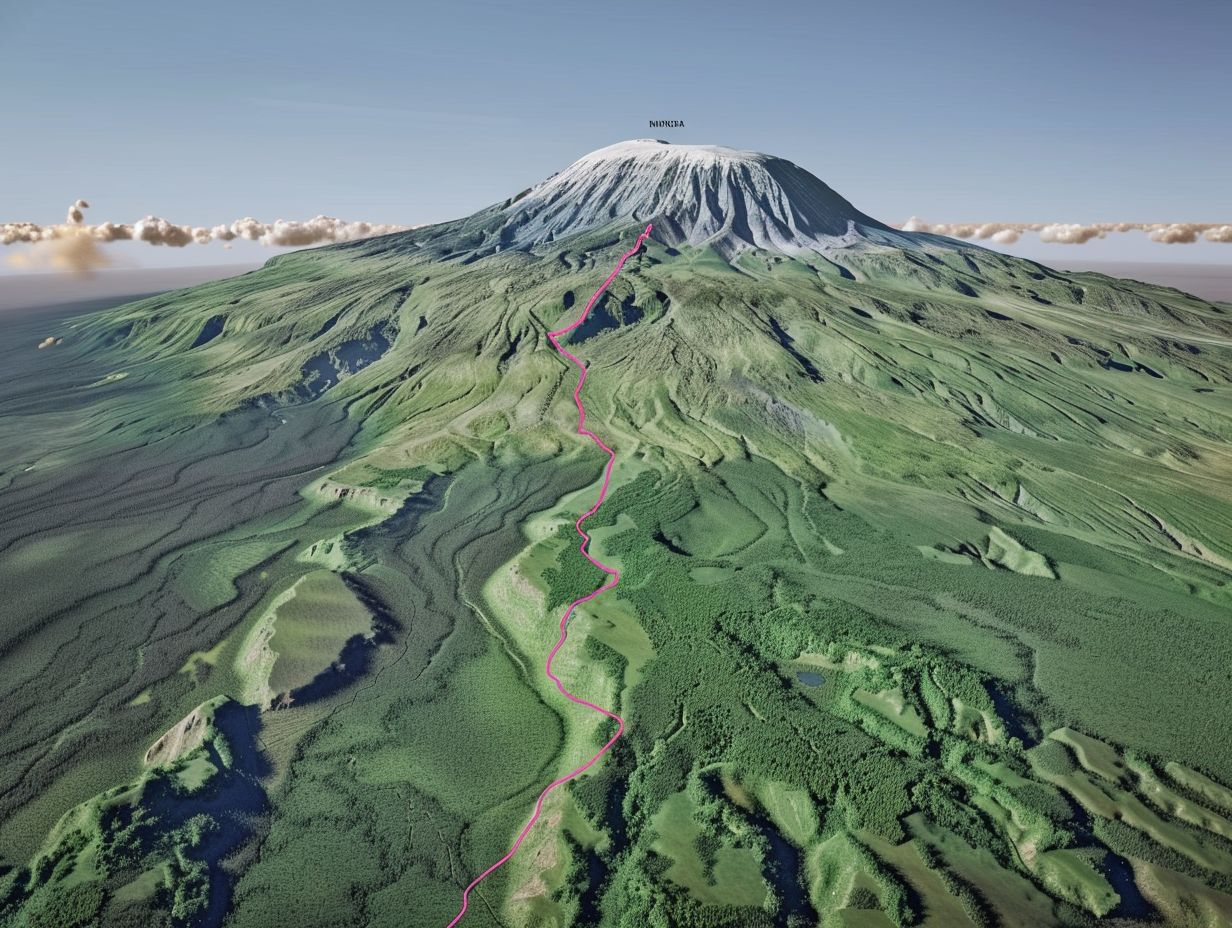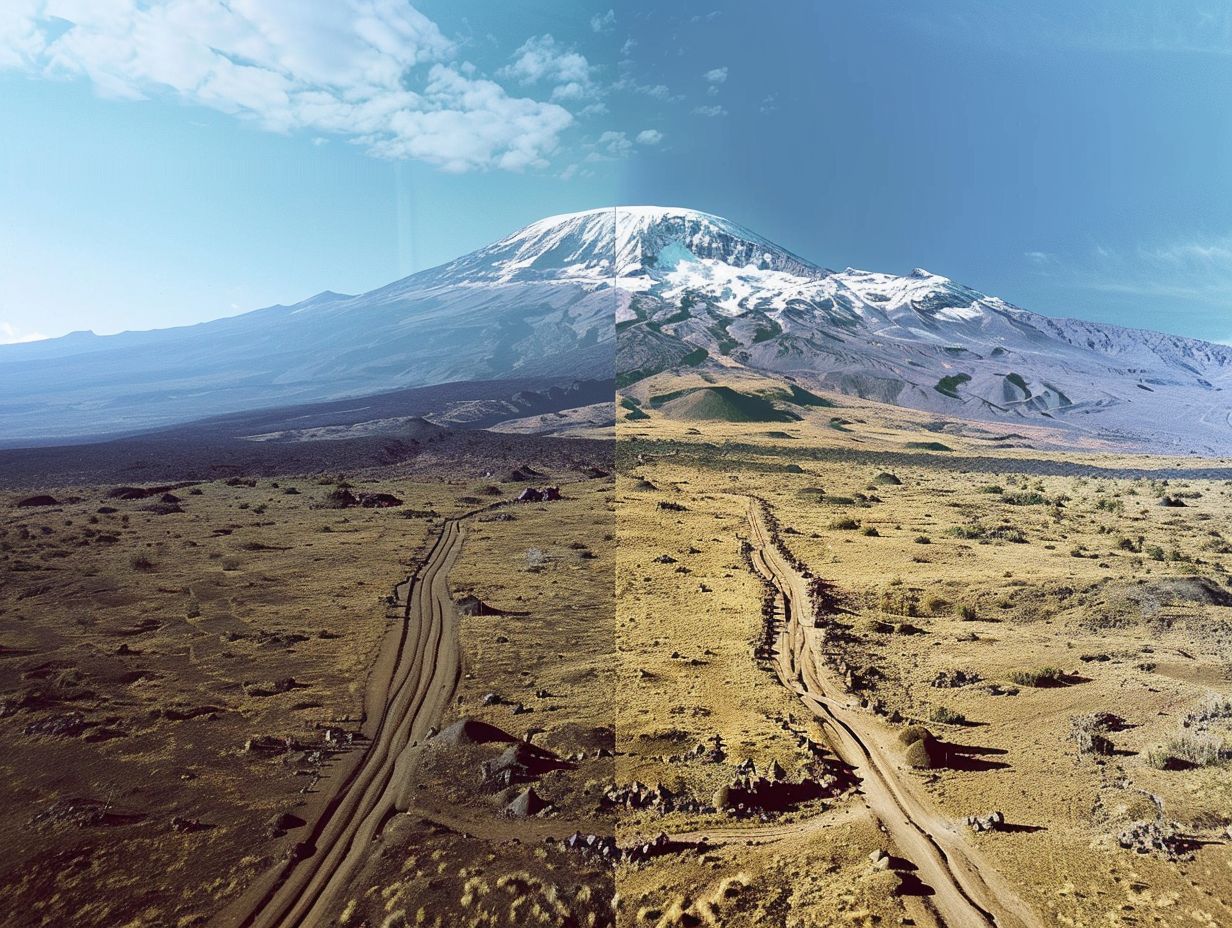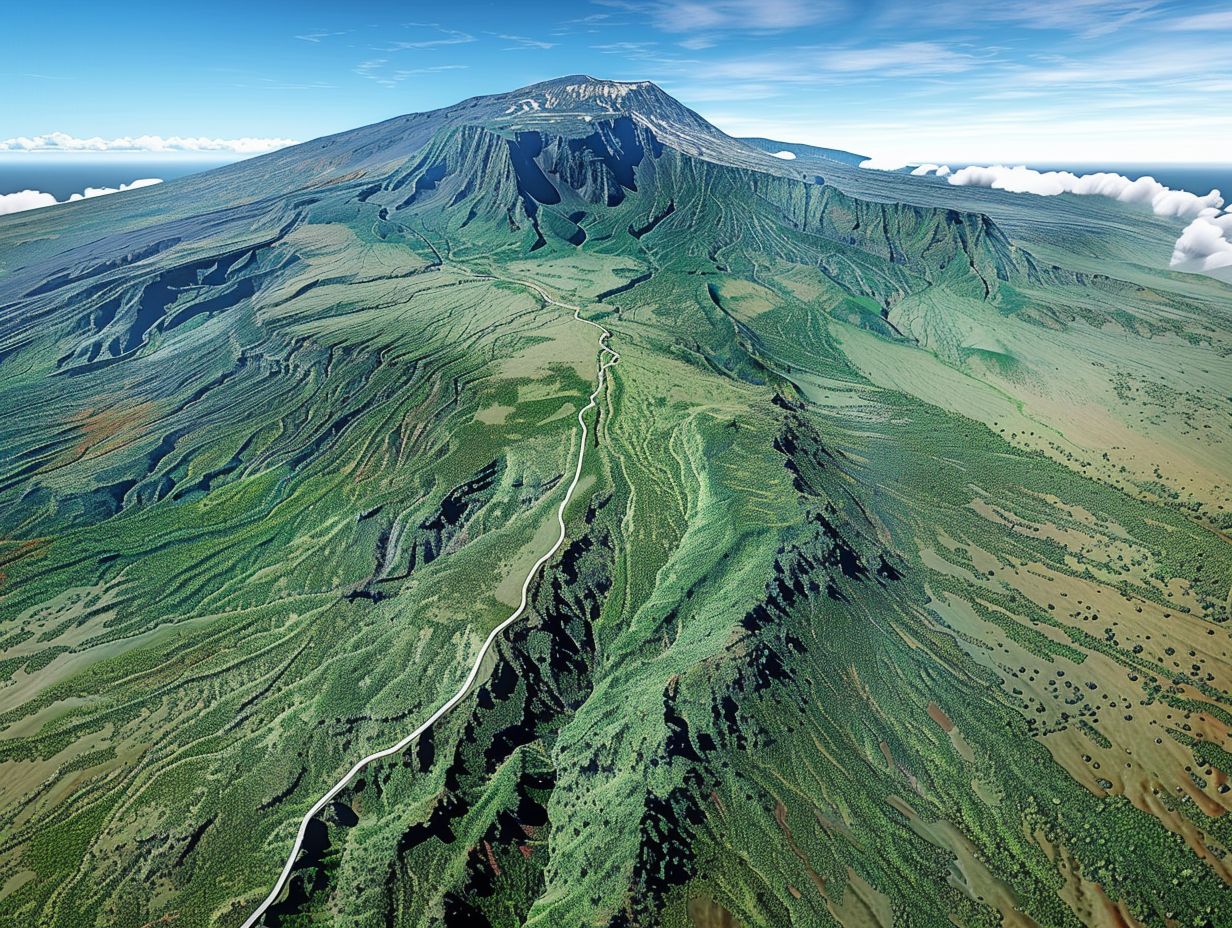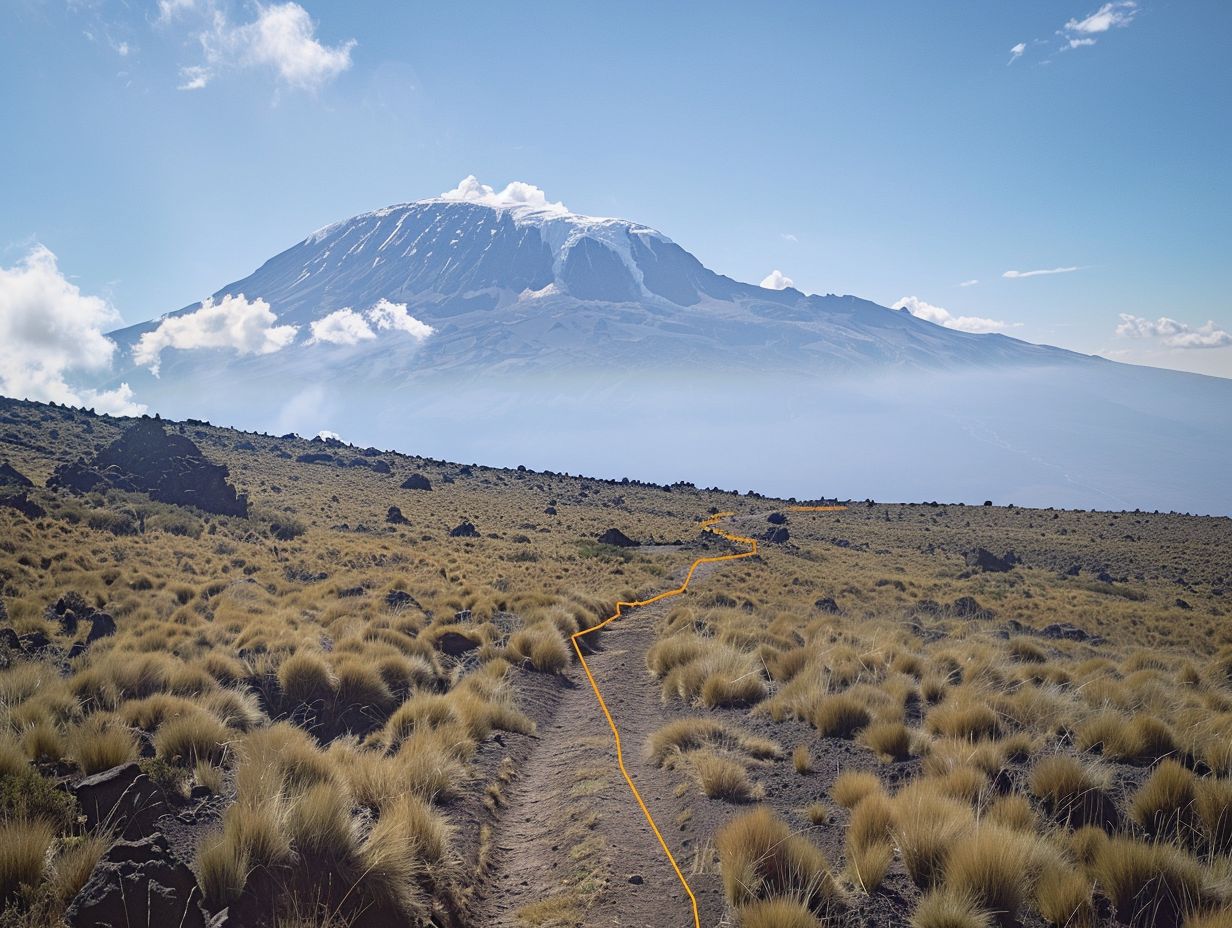
If you’re planning to conquer Mount Kilimanjaro, you may be wondering which route to take – Machame or Lemosho?
We explore the differences between these two popular routes, including difficulty level, scenery, duration, cost, and altitude profile. By the end, you’ll have a better understanding of which route may be more challenging and which may be the best fit for your experience level, budget, and goals.
Let’s help you make the best choice for your Kilimanjaro adventure.
Key Takeaways:

- The Machame Route is more popular among hikers due to its shorter duration and lower cost.
- The Lemosho Route offers more challenging terrain and stunning views, but requires a longer duration and higher cost.
- Choose the Machame Route for experienced hikers, the Lemosho Route for scenic views, and consider budget and acclimatization needs when deciding between the two.
What Are the Machame and Lemosho Routes?
The Machame and Lemosho Routes are two popular paths climbers take to conquer the majestic Kilimanjaro in Tanzania, offering distinct experiences and challenges.
While the Machame Route, also known as the ‘Whiskey Route,’ is often chosen for its relatively high success rate due to its gradual ascent and excellent acclimatization opportunities, the Lemosho Route, dubbed the ‘Ultimate Kilimanjaro Route,’ stands out for its scenic beauty and diverse landscapes.
The Machame Route typically starts from the southwest side of Kilimanjaro, featuring a varied terrain that includes lush rainforest, rocky ridges, and alpine desert. On the other hand, the Lemosho Route begins from the western side, presenting a longer, more gradual climb with stunning panoramas of the Shira Plateau and picturesque sunsets over the Great Rift Valley.
Machame Route
The Machame Route, also known as the ‘Whiskey Route,’ is one of the most scenic paths to the summit of Kilimanjaro, boasting a higher success rate due to its excellent acclimatization profile and varied landscapes.
Among the key features of the Machame Route are its six well-distributed campsites, providing ample opportunities for climbers to adapt to the increasing altitude. These campsites, such as Machame Camp, Shira Camp, and Baranco Camp, offer stunning views of the surrounding terrain and serve as crucial resting points during the ascent.
The difficulty level of this route is considered moderate to challenging, making it suitable for adventurous trekkers looking for a memorable experience. The gradual ascent allows for better acclimatization, enhancing climbers’ chances of reaching Uhuru Peak successfully.
Lemosho Route
The Lemosho Route is known for its remote wilderness and abundant wildlife sightings, offering a longer and more gradual ascent to Uhuru Peak, the highest point on Mount Kilimanjaro.
Traversing through diverse landscapes, the Lemosho Route provides trekkers with a unique experience, combining dense forests, moorlands, and stunning alpine deserts. This route appeals to adventurers seeking a more secluded journey, away from the crowds often associated with other paths up Kilimanjaro.
Wildlife enthusiasts will marvel at the various animals encountered along the way, such as monkeys, elephants, and a variety of bird species characteristic of the region.
The scenic beauty on the Lemosho Route is unparalleled, with breathtaking vistas of the Tanzanian plains and surrounding peaks. The gradual ascent allows for better acclimatization, increasing the chances of a successful summit bid.
The serenity of this trail, coupled with its pristine natural surroundings, makes it a popular choice among experienced climbers looking for a more rewarding and less crowded route.
Which Route is More Popular?
Regarding popularity, the Machame Route tends to attract more climbers due to its challenging yet rewarding nature, while the Lemosho Route offers a quieter and more secluded trekking experience.
One of the factors influencing the popularity of the Machame Route is its steep ascent, which provides a thrilling challenge for climbers looking to test their skills and endurance. This route is known for its diverse scenery, from lush rainforests to alpine deserts, offering a captivating journey to the summit of Kilimanjaro.
On the other hand, the Lemosho Route appeals to those seeking a more peaceful trekking experience, with fewer crowds and a slower pace. The route’s longer duration allows for better acclimatization, enhancing the overall trekking experience and increasing the chances of a successful summit bid.
What Are the Differences Between Machame and Lemosho Routes?
The Machame and Lemosho Routes exhibit notable differences in terms of difficulty levels, scenic beauty, trekking duration, and overall cost, catering to varied preferences and trekking styles.
While the Machame Route is known for its steeper sections and more challenging terrain, the Lemosho Route is often considered a bit more gradual and less physically demanding, making it a popular choice for trekkers looking for a slightly easier hike.
In terms of scenic beauty, both routes offer stunning views, but the Machame Route is renowned for its diverse landscapes, including lush rainforests, alpine deserts, and glacier-capped peaks, providing a more varied visual experience compared to the predominantly forested Lemosho Route.
Regarding trekking duration, the Machame Route is typically completed in 6-7 days, offering a faster ascent profile, whereas the Lemosho Route, being longer and more gradual, usually takes around 7-8 days, allowing for better acclimatization and reducing the risk of altitude sickness.
Regarding cost variations, the Machame Route is often slightly more affordable due to its shorter duration and popularity, making it a budget-friendly option for those seeking a challenging climb without breaking the bank.
On the other hand, the Lemosho Route tends to be a bit pricier due to its longer itinerary and more remote starting point, attracting trekkers willing to invest a bit more for a less crowded and more exclusive experience.
Difficulty Level

In terms of difficulty, the Machame Route is known for its steep sections and challenging terrain, requiring proper physical preparation and altitude acclimatization, whereas the Lemosho Route offers a more gradual ascent, reducing the risk of altitude sickness.
The Machame Route, often referred to as the ‘Whiskey Route’, is a popular choice for adventurers seeking a more strenuous climb. The trail’s steep sections demand hikers to have solid leg strength and endurance to navigate rocky paths and steep inclines.
Climbers on this route may face challenges like the infamous Barranco Wall, a nearly vertical climb that requires both physical and mental fortitude.
On the other hand, the Lemosho Route, known for its scenic views and diverse landscapes, provides a gentler climb, allowing trekkers to acclimatize more smoothly. This gradual ascent not only minimizes the risk of altitude sickness but also offers a more enjoyable hiking experience as climbers traverse through various ecological zones.
Scenery and Views
Regarding scenery, the Machame Route offers breathtaking vistas of the Barranco Wall and the iconic Lava Tower, while the Lemosho Route showcases diverse terrains and panoramic views of the surrounding landscape.
The Machame Route, known for its stunning beauty, immerses trekkers in a mesmerizing journey through lush rainforests and moorlands with picturesque views of Mount Kilimanjaro’s distinct features. Hikers on this route are treated to awe-inspiring glimpses of the rugged Barranco Wall, a natural rock formation that stands as a testament to the volcanic forces shaping the region.
Alternatively, the Lemosho Route offers a different charm, with its expansive vistas that unfold across varied landscapes. Trekkers can witness the transition from montane forests to alpine deserts, all while taking in sweeping panoramas of the savannah below.
Duration
In terms of trekking duration, the Machame Route typically spans 6-7 days, offering a gradual ascent to the summit, while the Lemosho Route extends to 7-8 days, allowing for additional acclimatization and a more relaxed pace.
On the Machame Route, trekkers usually start at the Machame Gate and hike through diverse landscapes, from dense rainforest to alpine desert, reaching the summit at Uhuru Peak. The itinerary includes stops at famous sites like Barranco Wall and Karanga Camp, with the final push to the top via Stella Point.
Conversely, the Lemosho Route offers a longer experience, providing more time for altitude adjustment. Starting at the Londorossi Gate, this route winds through pristine wilderness, granting stunning views of Shira Plateau and the Western Breach.
Cost
Regarding cost considerations, the Machame Route is often perceived as more budget-friendly, offering good value for money in terms of trekking services and facilities, while the Lemosho Route may entail higher costs due to its remote and less-traveled nature.
One of the primary reasons behind the cost disparity between the two routes lies in their popularity and infrastructure. The Machame Route, being one of the most frequently chosen trails, benefits from economies of scale, resulting in lower overall trekking expenses.
In contrast, the Lemosho Route’s exclusivity and less crowded trails necessitate additional logistics and support, contributing to its comparatively higher costs.
Altitude Profile
In terms of altitude profile, the Machame Route provides ample opportunities for proper acclimatization, contributing to higher success rates in reaching the summit, whereas the Lemosho Route offers a gradual ascent profile, aiding in altitude adaptation and summit success.
While the Machame Route gains altitude relatively quickly, it includes essential acclimatization days at various camps like Shira and Barranco, allowing trekkers to adjust slowly to the increasing elevation.
This strategically planned ascent helps reduce the likelihood of altitude sickness and improves the body’s capacity to cope with lower oxygen levels.
On the other hand, the Lemosho Route’s longer duration and steady climb offer hikers a more gradual approach to the summit, making it an excellent choice for those who prefer a gentler altitude transition.
The Machame Route’s popularity often results in heavier foot traffic, especially during peak trekking seasons like August and September. This increased competition for camping spots and potential overcrowding can impact the overall experience for some hikers.
In contrast, the Lemosho Route, known for its serenity and scenic beauty, provides a more secluded and peaceful trekking environment, ideal for those seeking a quieter, less crowded expedition to the summit.
Which Route is More Challenging?
Regarding challenges, the Machame Route is widely regarded as more demanding due to its steep sections, higher altitude gains, and rugged terrain, providing a thrilling yet strenuous climbing experience.
Aside from steep inclines, trekkers on the Machame Route face physically demanding conditions throughout the journey. The trail’s diverse landscapes, from dense rainforests to rocky paths, require a high level of endurance and stamina.
Altitude sickness is a common concern due to the route’s rapid ascent to higher elevations. The unpredictable weather adds another layer of difficulty, with climbers encountering rain, snow, and strong winds that test their resilience.
Which Route Should You Choose?

Choosing the ideal route depends on various factors such as trekking experience, budget preferences, acclimatization needs, and personal preferences, ensuring a tailored and rewarding Kilimanjaro summit experience.
For experienced hikers seeking a challenge, the Lemosho Route offers a rigorous climb through diverse terrain and fantastic scenery, making it a popular choice.
If budget constraints are a concern, the Marangu Route, also known as the ‘Coca-Cola Route,’ provides more affordable accommodations but can be crowded.
As acclimatization is crucial for a successful ascent, consider routes like the Machame Route, which allows for gradual height gain.
Those mesmerized by breathtaking vistas should consider the Rongai Route, known for its unique views and tranquility.
For Experienced Hikers
For experienced hikers seeking a challenging ascent, the Machame Route with its steep climbs, diverse terrain, and demanding physical requirements offers an exhilarating adventure to the summit of Kilimanjaro.
The Machame Route, known for its picturesque views and extensive wildlife encounters along the way, demands meticulous physical training and endurance. Acclimatization to varying altitudes is crucial for success, as the route ascends through several climate zones with changing landscapes.
Ensuring proper gear, including durable trekking boots, layers for varying temperatures, and hydration systems, is essential given the route’s demanding nature. Experienced hikers should be prepared for long hiking days, challenging rock scrambles, and potentially icy sections, particularly near the summit.
For Scenery and Views
For trekking enthusiasts charmed by scenic beauty and wildlife encounters, the Lemosho Route with its remote wilderness, diverse landscapes, and abundant wildlife sightings provides a captivating journey to the roof of Africa.
As you embark on the Lemosho Route, nestled on the western side of Mount Kilimanjaro, you are greeted with a kaleidoscope of natural wonders.
Traversing through lush rainforests brimming with unique flora and fauna, you gradually ascend to higher altitudes, where the terrain transforms into rocky outcrops and alpine meadows.
The breathtaking panoramic views from Shira Plateau and the challenging yet rewarding Barranco Wall are just a glimpse of the route’s allure.
For Budget-Friendly Options
For trekkers on a budget seeking cost-effective options, the Machame Route stands out as a budget-friendly choice, providing value for money in terms of trekking services, equipment rentals, and camping facilities.
Known for its diverse landscapes and stunning views, the Machame Route offers a thrilling trekking experience without breaking the bank. Travelers can benefit from affordable accommodation options, making it an ideal choice for those looking to maximize their adventure while minimizing costs.
With well-equipped rental shops along the trail, trekkers can save money by hiring gear instead of purchasing expensive equipment for the journey. The route’s designated camping sites not only offer budget-friendly rates but also ensure safety and comfort for overnight stays.
For Acclimatization Purposes
For climbers prioritizing acclimatization and summit success, the Lemosho Route known for its gradual ascent, excellent acclimatization profile, and lower altitude sickness risks offers an ideal path to conquer Kilimanjaro safely.
Ascending Kilimanjaro, the Lemosho Route not only allows trekkers to adapt better to higher altitudes but also provides stunning scenery, passing through diverse ecological zones. This longer route, typically completed in 7-8 days, gives hikers more time to adjust to the changing altitudes, reducing the risk of altitude-related illnesses.
Compared to other popular routes like the Machame Route, the Lemosho Trail has lower traffic, offering a quieter and more peaceful trekking experience amidst the breathtaking landscapes of Kilimanjaro.
Conclusion
Both the Machame and Lemosho Routes present unique opportunities for climbers to summit Kilimanjaro successfully, offering diverse experiences, stunning scenery, and excellent value for the trekking investment.
When looking closely at the two routes, the Machame Route is known for its popularity, often referred to as the ‘Whiskey Route,’ attracting a higher number of climbers seeking a challenging ascent.
On the other hand, the Lemosho Route, known as the ‘Wilderness Route,’ offers a more secluded and serene trek through diverse landscapes, fostering a deeper connection with nature.
Both routes entail varying durations, with the Machame being slightly shorter but steeper than the Lemosho, which provides a more gradual incline for acclimatization.
Frequently Asked Questions

What is the difference between Machame and Lemosho Route?
The main difference between Machame and Lemosho Route is the length and difficulty. Machame Route is a shorter and more popular route, while Lemosho Route is longer and less crowded. Lemosho Route also offers a more scenic and diverse landscape.
Which route is better for acclimatization?
Lemosho Route is considered to be better for acclimatization due to its longer duration and gradual ascent. It allows for more time for the body to adjust to the high altitude, reducing the risk of altitude sickness.
Do both routes have the same summit success rate?
Both routes have a similar summit success rate of around 85-90%. However, Lemosho Route has a slightly higher success rate due to its longer duration and better acclimatization.
Which route offers a more challenging climb?
Machame Route is considered to be more challenging due to its steep and rocky terrain. Lemosho Route, on the other hand, has a more gradual ascent and is less physically demanding.
Can I combine Machame and Lemosho Route?
Yes, it is possible to combine Machame and Lemosho Route. This is known as the Machame-Lemosho Combination Route, and it offers a more diverse and challenging trek. However, it is only recommended for experienced hikers.
Which route is recommended for a first-time trekker?
Machame Route is generally recommended for first-time trekkers due to its popularity and well-established trails. However, it is important to consult with a professional guide and choose the route that best suits your fitness level and preferences.